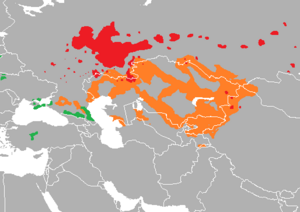لغات القپچاق
| قپچاق | |
|---|---|
| توركية شمالية غربية | |
| Ethnicity | قپچاق |
| Geographic distribution | آسيا الوسطى، روسيا, شمال القوقاز، أوكرانيا |
| Linguistic classification | Turkic
|
| Subdivisions |
|
| Glottolog | kipc1239 |
 | |
لغات القپچاق ( Kipchak languages ، وتُكتب أيضاً Kypchak ، Qypchaq ، Qypshaq، وتُعرف أيضاً بإسم اللغات التوركية الشمالية الغربية) هي فرع ثانوي من عائلة اللغات التوركية يتكلم بها نحو 28 مليون شخص في معظم آسيا الوسطى و شرق أوروپا، ممتدةً من أوكرانيا إلى الصين. بعض أوسع اللغات استخداماً في هذه المجموعة هي القزاقية والقيرغيزية والتترية.
السمات اللغوية
The Kipchak languages share a number of features that have led linguists to classify them together. Some of these features are shared with other Common Turkic languages; others are unique to the Kipchak family.
السمات المشتركة
- Change of Proto-Turkic *d to /j/ (e.g. *hadaq > ajaq "foot")
- Loss of initial *h (preserved only in Khalaj), see above example
سمات فريدة
مميزات العائلة
- Extensive labial vowel harmony (e.g. olor vs. olar "them")[بحاجة لمصدر]
- Frequent fortition (in the form of assibilation) of initial */j/ (e.g. *jetti > ʒetti "seven")
- Diphthongs from syllable-final */ɡ/ and */b/ (e.g. *taɡ > taw "mountain", *sub > suw "water")
المحصورة باللغات
- In both Tatar and Bashkir, the original mid and high vowels are swapped in position by vowel raising and lowering:
| Old Turkic | Tatar (for example) | ||
|---|---|---|---|
| Mid → high | |||
| *e | /e/ | i | /i/ |
| *o | /o/ | u | /u/ |
| *ö | /ø/ | ü | /y/ |
| High → Mid | |||
| *i | /i/ | e | /e/ |
| *ı | /ɯ/ | ı | /ɤ/ |
| *u | /u/ | o | /o/ |
| *ü | /y/ | ö | /ø/ |
التبويب
The Kipchak languages may be broken down into four groups based on geography and shared features (languages in bold are still spoken today):
| Proto-Turkic | Common Turkic | Kipchak | Kipchak–Bulgar (Uralian, Uralo-Caspian) | ||
| Kipchak–Cuman (Ponto-Caspian) |
| ||||
| Kipchak–Nogai (Aralo-Caspian) | |||||
| Kyrgyz–Kipchak (Kyrgyz) | Southern Altai Turkic[3] | ||||
| Kyrgyz[nb 2] | |||||
انظر أيضاً
Notes
- ^ Except for the Southern "dialect", which is classified among the Western Oghuz languages despite its dialect status.[2]
- ^ Although Kyrgyz isn't a language family, it is added to this table as such in order to ensure the formatting works correctly.
المراجع
- ^ Encyclopedia of Bashkortostan.
- ^ Yazyki mira Языки мира [Languages of the World]. Vol. 2. Indirk: Институт языкознания (Российская академия наук). 1997. pp. 19–20.
- ^ Some dialects are close to Kirghiz (Johanson 1998)
- ^ Nevskaya, I.A. "The Teleut Language". Endangered Languages of Indigenous Peoples of Siberia. UNESCO. Retrieved 2021-07-16.
ببليوگرافيا
- Johanson, Lars; Csató, Éva Ágnes (1998). The Turkic Languages. London: Routledge. ISBN 0-415-08200-5.
- Menges, Karl H. (1995). The Turkic Languages and Peoples (2nd ed.). Wiesbaden: Harrassowitz. ISBN 3-447-03533-1.